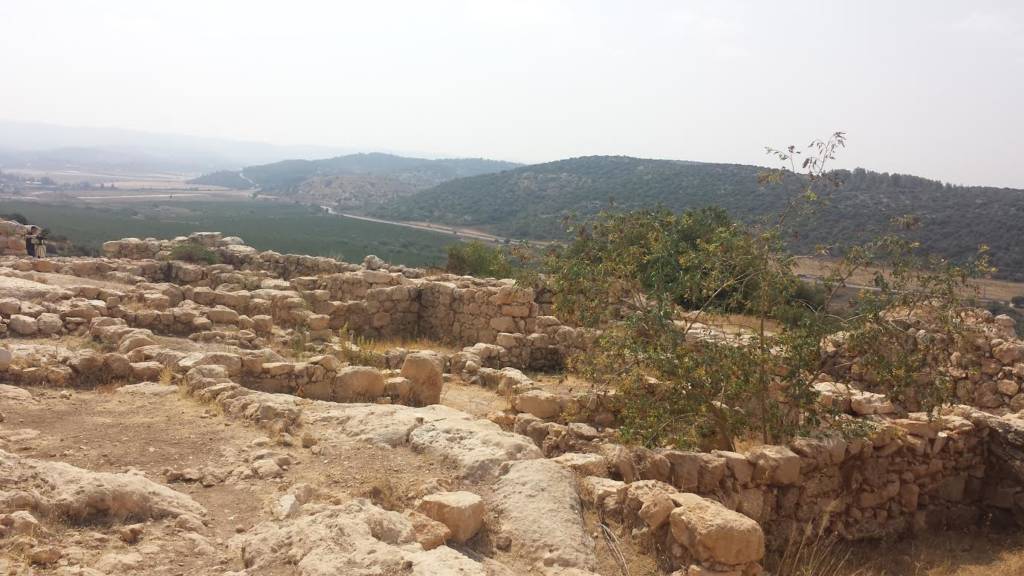On a tiny hilltop in the middle of the Elah Valley, near the city of Beit Shemesh, an ancient city was uncovered, with features and details that seem to match the biblical account of the region. Whether this discovery provides physical evidence of the existence of a Davidic stronghold in the Elah Valley is the subject of academic debate that will likely continue for generations to come.
In 2007, a team of archaeologists, led by Yosef Garfinkel of the Hebrew University of Jerusalem, Saar Ganor of the Israel Antiquities Authority and Prof. Michael Hazel of the Southern Adventist University of Tennessee, began digging on a small hilltop in the Elah Valley, where, according to the famous biblical account, King David slew Goliath. The excavations, which continued until 2013, uncovered an ancient city that boasted sophisticated architectural design identical to that in the Judean cities 3,000 years ago, during the time of King David and King Saul.

Unique stone-carved cultic shrine model matching biblical descriptions of King Solomon’s Temple and his palace in Jerusalem on display at museum exhibit. (Atara Beck/UWI)
The city was built between Sokho and Azekah, in the Judean lowlands on the border between the coastal plains inhabited by the Philistines and the Judean Hills to the east. Carbon14 dating, on charred olive pits excavated from the foundation layers of the site, have determined that this city existed between the late 11th century BCE and early 10th century BCE, the beginning of the Kingdom of Israel. The city was deliberately planned and organized in a manner that pre-dates any other urban structure in this region. It was surrounded by a massive wall that included two equally large and dominant gates; a very unusual feature for a relatively small city.
When the archaeologists excavated these gates, they were reminded of the biblical city of Sha’arayim (literally ‘two gates’ in Hebrew), from the biblical story of David and Goliath. Historians and archaeologists suspect that the Kingdom of David had spread south, and that the city may have been established as a frontal outpost against the Philistines to control the main road leading the Judean hill country.
Findings at the site, known today as Khirbet Qeiyafa, included fascinating artifacts, among them an intriguing inscription which to date is the oldest Hebrew writing ever to be discovered. A unique stone-carved cultic shrine model decorated with architectural elements seems to echo the biblical descriptions of King Solomon’s Temple and his palace in Jerusalem.
Now, 3,000 years later, we are offered a glimpse into the daily lives of the people, including insight into the administration of the city, which was obviously controlled by a powerful and well-organized political entity.
On September 5, the Bible Lands Museum Jerusalem will open an exciting exhibit displaying these archaeological findings, titled “In the Valley of David and Goliath.” Nearly all findings on display were excavated at the site, including cookware, tools and weapons. In addition, the historic Tel Dan stele, from the 9th century BCE, is on loan to the museum. This inscribed stone was originally stationed in the gate of the ancient city of Dan in the Hula Valley. The inscription, in Aramaic, refers to the kingdom of Judah as “Beith David” – Hebrew for ‘The House of David’. The Tel Dan stele is the only written evidence found to date that verifies the existence of the Kingdom of David.
This fortified, carefully planned city may indicate the presence of a powerful kingdom in Judah as early as the 10th century BCE. The absence of pig bones, the almost complete lack of typical Philistine pottery, and the possible earliest Hebrew inscription, support the theory that this could not have been a Philistine city. Pig bones and vast quantities of Philistine pottery were found in excavated Philistine cities such as in Gath, Ashkelon and Ashdod. Prof. Garfinkel believes that the findings prove that this city was founded by King David and can be linked with the biblical city of Sha’arayim.
‘Archaeology is our History’
“Archaeology is our history,” says Amanda Weiss, director of the Bible Lands Museum. “The exhibition gives the public a chance to see these exciting finds that have made Qeiyafa a key site in understanding the social and historical processes that took place in the early days of the Kingdom of Israel. Visitors to the exhibition will step into a world that once vanished, and will witness a moving historic testimony of the everyday life of the residents who lived on the border between Philistia and Judah. We are proud to present this exhibition which gives people of all ages and from around the world the opportunity to go back 3,000 years in our history – to the time of King David.”
By: United with Israel Staff
With files from the Bible Lands Museum Jerusalem
Sign the Declaration to Keep Jerusalem United
Jerusalem Must Remain the United Capital of Israel
I declare that Jerusalem is the eternal capital of the Jewish People and support all efforts to maintain and strengthen a united Jerusalem as the undivided capital of the State of Israel.
CLICK HERE TO SIGN THE JERUSALEM DECLARATION.
Do You Love Israel? Make a Donation - Show Your Support!
Donate to vital charities that help protect Israeli citizens and inspire millions around the world to support Israel too!
Now more than ever, Israel needs your help to fight and win the war -- including on the battlefield of public opinion.
Antisemitism, anti-Israel bias and boycotts are out of control. Israel's enemies are inciting terror and violence against innocent Israelis and Jews around the world. Help us fight back!
